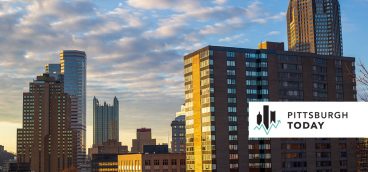Does Air Quality Matter to Young Workers?

As their due date neared last fall, Ryan Poling and his wife faced a difficult decision. Did they want to raise their daughter in Pittsburgh, the city in which they’ve built a life during the last nine years, or pick up and move across the country, near Poling’s family in California?
“It’s really hard to think about leaving,” said Poling, of Point Breeze. Though family was the main factor in their decision, it wasn’t the only one. “The secondary push is the air quality. It’s just horrific. We don’t want our daughter to grow up breathing this stuff.”
Pittsburgh’s “smoky city” days are past, but the region’s air remains among the most polluted of the country’s metropolitan areas, according to The American Lung Association’s rankings. Last year, the association put it at No. 8 in its list of cities with the most annual particle pollution.
But unlike the cities higher on the list, such as Los Angeles and San Francisco, Pittsburgh has struggled to attract residents and workers, particularly young adults. In each of the past three years, people leaving southwestern Pennsylvania have outnumbered those moving in, U.S. Census data show. Such trends raise concerns about the viability of the region’s future workforce.
And those who’ve tried to convince people to move here are divided as to what extent air quality affects the region’s ability to attract new workers. But it has kept some away, said Andrew Moore, former director of Google’s Pittsburgh office.
“The air quality issue is the No. 1 issue that loses me strong engineers, strong scientists,” said Moore, who is now dean of the School of Computer Science at Carnegie Mellon University. “I think it’s been improving, but not very rapidly.”
He hasn’t had the same problem with candidates for faculty positions at CMU, he said. But “when a faculty candidate mentions this, I have to be transparent,” Moore said. He said he tells them, “Yes, it is appalling, but if you look at the evidence over the last couple of years, Pittsburgh is trying to do something about it.”
Not enough, though, said Mark Dixon, an independent filmmaker who moved to Pittsburgh in 2006. Dixon has mounted a $200 air sensor on his Squirrel Hill porch. He matches the data with crowd-sourced reports of strange smells logged by the Smell PGH mobile phone application to figure out when it’s safest to go jogging.
If a friend asked for advice about moving here, Dixon said he’d lay out his complicated relationship with his adopted hometown.
“I’d tell them I love Pittsburgh. I love the community here. I love that I can barely step into any social scene and not see somebody I know and like. I like the access to public officials. I love the size of the city. I like where it’s heart is. But I’d say you need to look at the statistics on air quality in Pittsburgh and decide whether that’s problematic for you. If you have a small child, I’d say you really have to think hard about it because the statistics for children with asthma are bleak.”
Dixon is working on a documentary about the region’s air quality with the working title, “Inversion: The Unfinished Business of Pittsburgh’s Air.”
“It’s a climate issue,” Dixon said. “It’s a social justice issue. It’s an environmental justice issue. It’s a health issue. It’s a political issue.”
His struggle with air quality connected him to a group of people, many of them transplants in the tech industry—a “geek posse,” he called them—with whom he has discussed building an algorithm that uses publicly available pollution and weather monitoring data to predict when the air quality is about to drop.
One of them is Paul Boone, lead developer at the Wilmer Lab at the University of Pittsburgh. Boone moved from Los Angeles to Pittsburgh in February 2016 to pursue a Ph.D. in chemical engineering. Though Los Angeles typically ranks even worse than Pittsburgh in air quality studies, Boone said he avoided the problem by living in Venice Beach, “because the air quality felt better.”
Like Dixon and Poling, it took Boone a while to realize there was an air quality problem. Boone, who moved to the city in February 2016, first noticed a smell when the weather warmed and he left his windows open.
“I thought my basement neighbors were doing something weird,” Boone said. “I thought they were emptying the trash or doing something with mushrooms I didn’t understand.” But the smell—which he described as “a peppery, industrial, diesel smell”— persisted when he walked through Squirrel Hill to catch the bus. “It’s interesting to see how a lot of the locals can’t smell it.”
Boone bought a house, but he’s unsure whether he’ll stay in Pittsburgh after earning his degree in four years. The air quality will be a factor. “Why would you live somewhere where you can tell the air is killing you?” he asked. “That is the main reason why I wouldn’t stay.”
“There are so many things that are happening in Pittsburgh. Because it’s so cheap, because it’s recovering from the drop in population, you can start a business for next to nothing. It gives you so much more flexibility. But the backdrop is, one of the reasons it’s still so cheap is the pollution. That discourages people of my age and with my educational background from coming,” said Boone, who is in his mid-30s.
Attracting tech workers involves special challenges, said Audrey Russo, president of the Pittsburgh Technology Council.
“If you have a computer science background, an engineering background, you’re in higher demand. If you don’t have any connections here that root you—family, friends, having gone to college here—I think there’s a list of things you have to consider.” Though companies have expressed concern to her about air quality, she said their workers are also interested in traffic (a plus for Pittsburgh, compared to West Coast metropolises) and direct flights (a minus).
There’s an additional challenge in that tech jobs don’t always need to be in the same place their company is headquartered. Howard Hanna Real Estate Services had to deal with that wrinkle three years ago, when the firm bought the Denver-based call center company One Cavo, CEO Helen Hanna Casey said.
“I think Denver was a special case,” she said, because Denver markets itself as a destination for people with an outdoorsy lifestyle, far more than most cities. “Trying to talk to them about moving here, that’s the only time I’ve ever heard [southwestern Pennsylvania’s air quality] being mentioned.” The head of the call center relocated, but the rest remained behind, since the nature of their work allowed them to perform it anywhere.
People looking to relocate worry more about the quality of schools, property tax rates and access to health care, said John Yocca, owner of the recruitment firm A.C. Coy. “I don’t think I’ve ever seen that [concern about air quality] in all the years I’ve been doing this,” said Yocca, whose firm focuses on recruiting people for technology companies.
Though location might be flexible with tech jobs, the region’s fossil fuel industries require their workers to be here. The state Department of Labor and Industry estimated that, in the second quarter of 2016, 52,531 people in the state were employed in the natural gas industry and companies that do business with the industry. Shell estimates its multi billion-dollar cracker plant in Beaver County will create as many as 6,000 construction jobs and 600 permanent jobs.
Poling, Dixon and Boone see the plant as a regional test, a choice between the industrial economy of its past and the technology-based work of the future. But the two aren’t mutually exclusive, argued David Spigelmyer, president of the Marcellus Shale Coalition, a trade association for the natural gas industry.
“Folks try to set up this false choice that you can’t have energy production and environmental stewardship at the same time,” Spigelmyer said. “We’re in the business of selling natural gas, not in the business of emitting it. We have every incentive to make sure we capture every molecule that’s produced.”
As for Shell’s new facility, “every bit of that plant is being built to the highest environmental standards,” Spigelmyer said. “You don’t have to make a choice between environmental compliance and jobs. We can do both.”
The region’s future hinges on it, Moore said.
“The numbers are the thing that counts,” Moore said. “As long as the particulate matter curves continue to decline in the same way they have been, we’re fine. On the other hand, if an industry comes in that flattens them or makes them worse, that’s a problem.”





